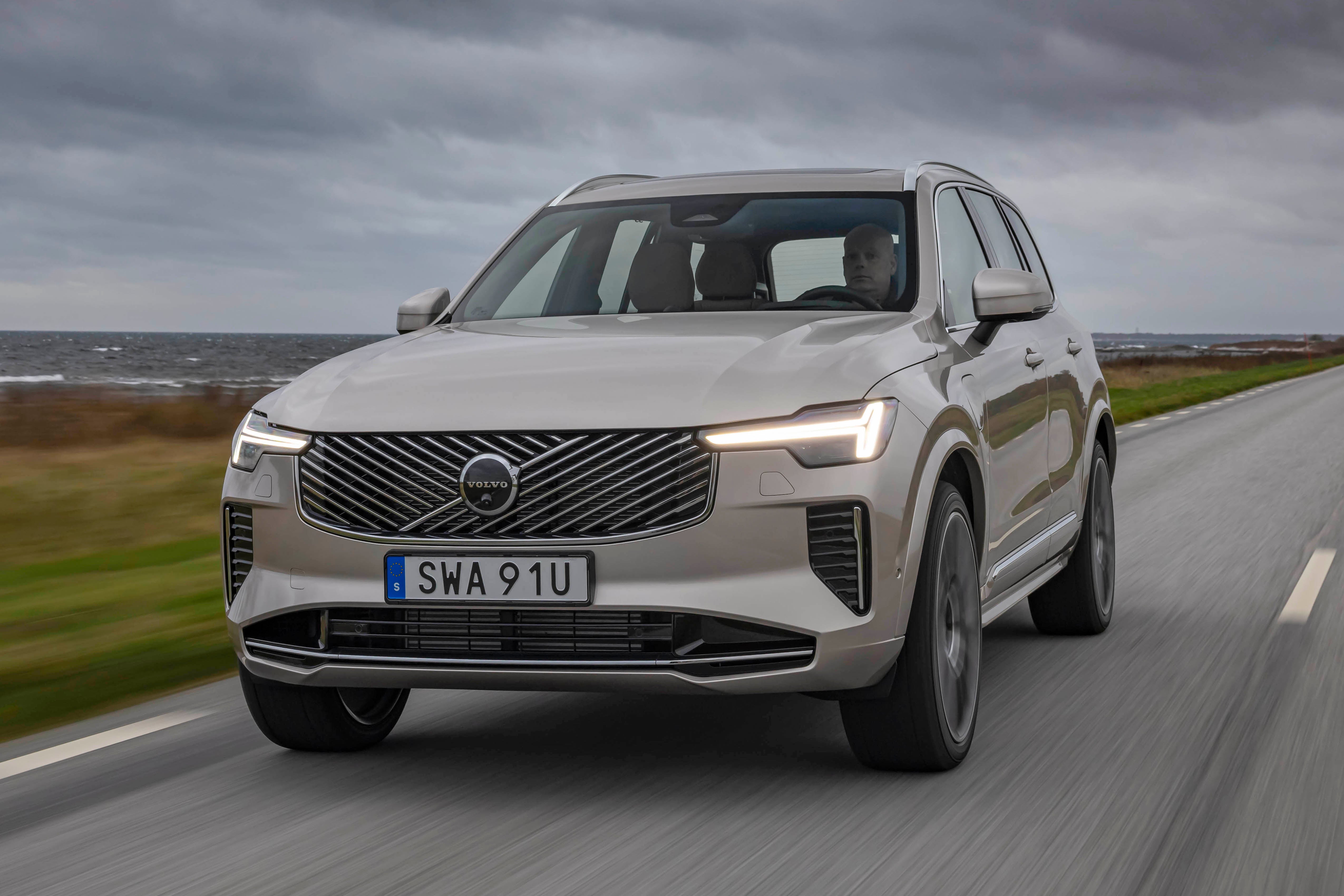Volvo XC90 Review 2025: Price, specs & boot space
Written by Phil Hall
Quick overview
Pros
- Modern design that’s like nothing else in the class
- Hugely practical, even for a large family
- Loads of luxury and safety kit as standard
Cons
- Not quite as good to drive as its best rivals
- PHEV range a little disappointing
- You’ll need a few quid to buy one
Overall verdict on the Volvo XC90
"The latest Volvo XC90 is still one of the most desirable SUVs money can buy. It still looks fresh today, while its upmarket interior is spacious enough to carry seven people. Combine that with an electrified engine line-up and the XC90 is very worthy of your consideration."
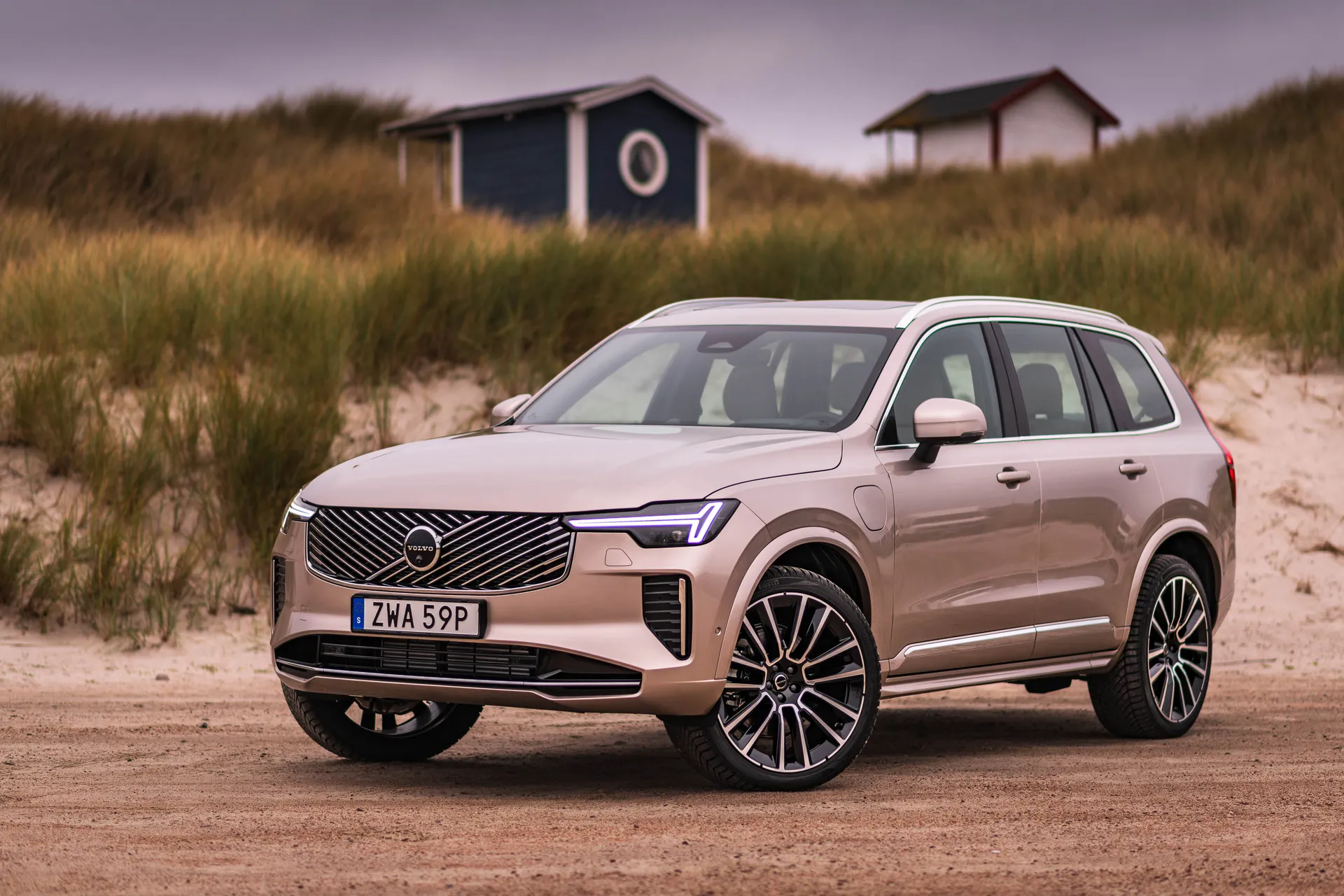
With the arrival of the all-electric EX90 and the brand looking ahead to an electric future, you might be forgiven for thinking that the Volvo XC90's days are numbered, especially as this second-generation model appeared back in 2015. However, the XC90 is still one of Volvo's best-sellers, prompting its most significant update since its launch almost ten years ago. Is this still the best seven-seat SUV money can buy? Find out in our full Volvo XC90 review.
This latest update sees the XC90 get it's most notable styling revision yet, while there's a freshened up interior and infotainment system that's been bought bang up to date as well.
Starting with the exterior first and the you'll instantly notice the revised front end - this sees a new grille, front bumper design and a new take on Volvo's signature 'Thor's Hammer' LED headlights. Moving round to the back and the changes are less obvious - you might spot some tweaks to the bumper, while the rear light clusters are darker. All these changes might sound minimal, but combined with the clean, modern design of the rest of the XC90 and it means that it looks and feels very distinct from its competitors. Even more vitally, it makes the Volvo every bit as desirable as any of its premium-badged rivals. Overall, we reckon the Volvo XC90 looks the absolute business.
The changes are just as notable on the inside - a quick glance around an you'll notice some design tweaks to bits of the dashboard, doors and the centre console, though you'll probably be too distracted by the new 11.2-inch infotainment touchscreen. Noticeably bigger than the 9.0-inch display found in earlier iterations of the second-generation XC90, it looks like a carbon copy of that found in the EX90. However, it's actually a bit smaller - the EX90's infotainment screen measures 14.5-inches. We'll dive into more detail on how it performs further in the review, but it's safe to say its a welcome upgrade that's more intuitive than before.
What hasn't changed is how this big Volvo has most of its rivals beaten on the other super-important area for a big SUV: practicality. It has seven fiendishly clever seats as standard, more space than most rivals, and an enormous boot. All that in a cabin that’s stuffed with luxury equipment and lavishly appointed. Not quite as lavishly as its very best rivals, admittedly, but really not far off.
On the road, meanwhile, the Volvo XC90 has what it takes to live with most of its rivals. It’s a very easy-going car to drive, concentrating on wafting its occupants along in comfort and tranquility, rather than trying to provide any excitement, and it’s all the better for it. This is especially true if you opt for the air suspension set-up available on the XC90. When the road turns twisty, mind you, there’s enough control to keep things feeling stable and assured. Not the finest car of its type on either ride or handling, then, but it delivers a good balance of abilities nonetheless.
An automatic gearbox, four-wheel drive, and hill descent control are all standard across the board, but don’t go thinking this is an off-roading SUV. The XC90 is a car designed to tackle school runs, rather than green lanes.
In the past there have been a number of petrol and diesel engines available with the XC90, but these are only available as used models. There's now a simple choice of a B5 mild-hybrid engine, or the more T8 plug-in hybrid variant (and one of the best hybrid SUVs going) thanks to its scarcely believable mix of performance and economy. With an official range of just over 44 miles, range isn't a match for some newer rivals.
And, being a Volvo, you can always have ultimate confidence in the safety of the car. The Swedish firm’s peerless knowledge in this area, and the vast amount of safety equipment squeezed into the XC90, make it one of the safest cars in the class, critically important in a car designed to ferry lots of people around.
Overall, the Volvo XC90 is a really good all-rounder that’s worthy of consideration. Class-leading on style, character, safety and practicality, and in the mix in every other area. No wonder it's proved so popular.
Looking for a used car for sale? We've got 100s of Volvo Approved Used Cars for Sale for you to choose from, including a wide range of Volvo XC90s for sale.
Is the Volvo XC90 right for you?
If you’re after a big, luxurious SUV with seven seats, but you want a bit more style, charm and character than the myriad German offerings can muster, then the Volvo XC90 will be right up your street.
While the styling of many rivals could be accused of being overly conservative - even borderline derivative - the Volvo XC90 offers a real dose of individuality. Inside and out, it looks modern, yet timeless. Classy, yet funky. And it’s that effortlessly cool vibe that makes the Volvo XC90 a real breath of fresh air in the class.
That's not the car’s only trick, mind you. It has the space, practicality and versatility to slot straight into the life of any large family, thanks to a huge passenger compartment, an ingenious seating system, and a huge boot. Chuck in a very capable driving experience, impressive mechanical refinement, loads of standard equipment and you have an extremely appealing family bus.
What's the best Volvo XC90 model/engine to choose?
You'll be able to order a new Volvo XC90 with either a mild-hybrid petrol engine or as a plug-in hybrid, though the used market has a variety of petrol and diesel options available as well.
The B5 mild-hybrid engine is a solid option, but it can sound pretty strained when you put your foot down. Our pick would be the T8 plug-in hybrid engine - it's quieter thanks to the extra help from the battery, while it really does surge along. That's not forgetting the official 44.1 mile of electric range on tap as well, though it won't get you as far as some rivals.
The new Volvo XC90 is available in three trim options, with even the entry-level 'Core' version is very well equipped, though we'd be tempted by the Plus trim that sits in the middle of the range and comes with nice extra luxuries, including air suspension and a panoramic roof. Top of the range Ultra models are dripping with kit, including a stunning Bowers & Wilkins stereo system.
What other cars are similar to the Volvo XC90?
If you’re after a big, luxurious, premium SUV, there’s no shortage of choice. Any German manufacturer worth its salt will offer a variety of choices, and don’t rule out the likes of Land Rover and Lexus, either. However, the fact that the XC90 comes as standard with seven seats sets it apart slightly, because although most rivals can be specified with seven, many only have five as standard.
For that reason, the Volvo XC90s most direct rivals are the Audi Q7 and Land Rover Discovery, but the BMW X5, Mercedes GLE, Porsche Cayenne and Lexus RX will also be vying for your (considerable amount of) cash. Alternatively, if you're after a luxury electric SUV with seven seats, then take a look at another car from Volvo, the brilliant EX90.
Comfort and design: Volvo XC90 interior
"Volvo has also developed a reputation for making some of the best seats in the business, and you’ll see why as soon as your behind hits the leather; the XC90’s chairs are wonderfully supportive and comfortable."
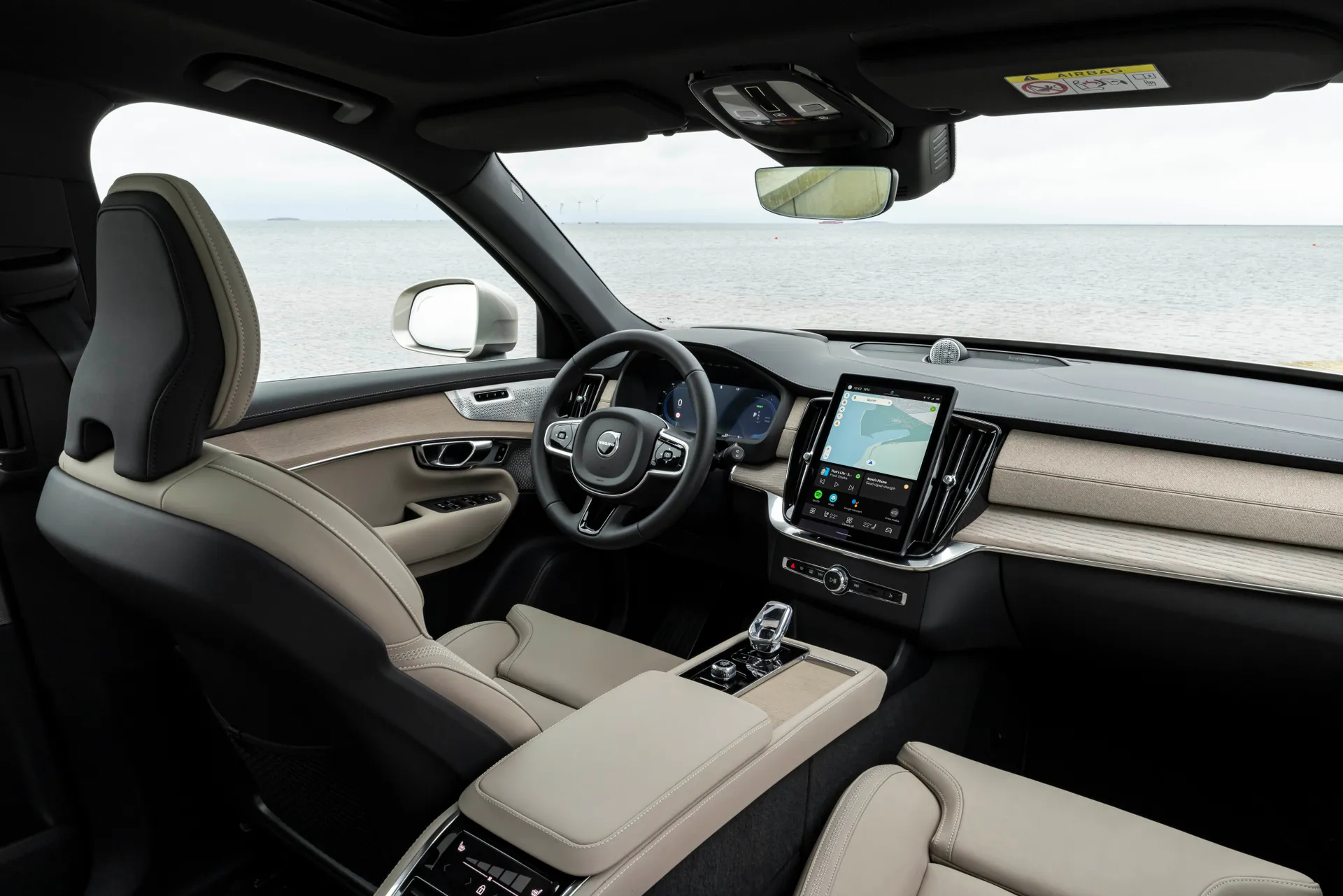
Getting comfy at the wheel of the Volvo XC90 is an absolute doddle because all versions come with a driver’s seat that adjusts electrically, allowing you to fine-tune your seating position just-so. There’s also lots of adjustment for the steering column, while the wheel and pedals are slap-bang in front of you.
You get a pretty clear view out in all directions thanks to big windows with relatively skinny pillars. Your over-the-shoulder view will suffer if you’re fully loaded with passengers, but that’s the case in any seven-seater.
The dashboard features very few switches (those that remain are lined up neatly on the centre console), with most functions being operated through the large 11.2-inch touchscreen infotainment system.
Even the most basic Core trim enjoys heated front and rear seats, a checkered aluminium trim and a quilted Nordico seat upholstery. Move up the range, and things get posher. The Plus has a panoramic glass roof and Harmon Kardon stereo, while the Ultra gains front massage seats with ventilation, Nappa leather upholstery and a Bowers & Wilkins stereo system.
If you're searching for an XC90 on the used market, Volvo offered Momentum (much the same as Core), Inscription, and R-Design models, the latter adding sporty styling bits like a sports steering wheel and a black headlining, while Inscription cars have higher grade leather on the seats, leather on the dashboard and plush wooden inserts.
Quality and finish
The Volvo XC90’s interior is the perfect match for the outside, because it gives exactly the same impression of style, sophistication and classiness.
The swish, modern design is unlike anything else you’ll find in the class, and most of the materials used are just as high-grade as those you’d find in rivals from Audi or BMW. Volvo's paid attention to the little details, with the quality of the new cabin even better than before and feels like a wonderfully inviting, high-class environment when you step inside.
Infotainment: Touchscreen, USB, nav and stereo in the Volvo XC90
As we've touched on, previous iterations of the XC90 featured a 9.0-inch touchscreen, and will the quality was good, we found the screen transitions to be a bit on the slow side, while some features required a few taps to get to them. The new 11.2-inch touchscreen successfully fixes these issues in most cases.
Sitting in the middle of the dash, the graphics are crisp, clear and stylish, mirroring the interfaces we've seen on both the EX90 and to a certain extent, the EX30. Despite the XC90's age, this gives the XC90's interior a modern feel, and for the most part, the system works pretty well thanks to logically arranged menus, though some might still be frustrated by the over reliance of touchscreen interaction when driving, especially when it comes to cabin temperature adjustment.
As we've seen with previous Volvos, the XC90's infotainment is based around a version of Google's Android Automotive, and as such it has things like Google Maps, Google Assistant and Google Play seamlessly integrated into the interface. Navigation takes most of the screen's real estate by default, followed by smaller sections below for media and phone contacts. Underneath this is access to heating, ventilation and air-con controls. If you're an Apple user and don't want to embrace the suite of Google features on offer, there is Apple CarPlay wireless connectivity.
A rear camera is standard, though Plus models and above get a 360-degree camera as standard, while there's a 13-speaker Harman Kardon stereo on the Plus model, with the brilliant 1,100W 19-speaker B&W stereo reserved for the top-spec Ultra trim.
Space and practicality: Volvo XC90 boot space
No car of this size and type struggles to make life comfortable for lofty folk in the front, and the Volvo XC90 is no different. There’s loads of headroom and legroom, and the wide cabin gives you lots of shoulder space, too. Cabin storage is impressive up front. The glovebox is bigger than most, there are two cupholders (now with smaller slot for thin drinks cans) and a cubby in the centre console, while the big door pockets will hold a large water bottle, as well as a bunch of other stuff.
Similarly, you’d have to be built like a Harlem Globetrotter to struggle to get comfy in the middle row of seats. The Volvo XC90 is marginally more generous than most of its rivals for head- and legroom, although the former does reduce a smidge if you go for a car with the optional panoramic roof.
All three middle-row seats can be slid, reclined or folded independently of each other for maximum versatility, and there’s also enough shoulder space that all three can be occupied by an adult all at the same time in reasonable comfort. That said, whoever winds up in the middle will get a harder, less comfy seat than those either side, and will also have to straddle the bulky transmission tunnel.
Unlike in many rivals, even the seats in the third row (which are standard across the board) have enough space for an average-sized adult, but if you’re six foot or more, you’ll definitely want to shotgun one of the pews further forward. It’s also worth noting that you even get seven seats with the plug-in hybrid version of the Volvo XC90. With the equivalent versions of most rivals -the Audi Q7 for example - the rearmost row has to be deleted to make way for the batteries.
Even with all seven seats in place, there’s enough boot space for a weekly shop (a small hatch-rivalling 302 litres), and if you drop the third row, the boot becomes absolutely massive. With an official capacity of 680 litres (640 litres for the T8 plug-in hybrid), the XC90 can easily swallow pushchairs, golf clubs and suitcases. Turn your XC90 into a two-seater, and the cargo space on offer puts many vans to shame. What’s more, because all the seats easily fold flush into the floor, the load area you get is perfectly level.
The Volvo XC90 measures 1771mm in height, 4953mm in length and 2008mm in width (2140mm including door mirrors).
Handling and ride quality: What is the Volvo XC90 like to drive?
"Ride comfort is important in any car designed to carry seven people, so it’s good news that the XC90 does a thoroughly presentable job on that score."

Even on its standard suspension, it’ll soak up most of what a scruffy road surface can throw at it, keeping life nice and settled. True, it doesn’t isolate you from low-speed bumps and ruts quite as well as some rivals, so urban journeys can sometimes feel a bit more jittery than they would in, say, an Audi Q7. Things become more settled at higher speeds, though, making the big Volvo a very capable cruiser, even if again, a Q7 will be even slicker and more cosseting on the motorway.
Adaptive air suspension is also available either as an optional extra on Core models, or standard on both Plus and Ultra trim cars. Even with the 22-inch alloy wheels that were on our Ultra trim test car, the XC90 felt really fluid over potholes and speed bumps, while on longer journeys you'll waft along in serene comfort.
With all XC90s, the handling is very capable. There’s lots of grip and decent body control, so it feels stable and assured in bends. It’s not as much fun as a BMW X5 or Porsche Cayenne on a twisty road, but it feels considerably less wallowy than a Land Rover Discovery. The steering doesn’t offer much in the way of feel, but it's consistently weighted and not too slow. The brakes can be hard to modulate in the plug-in hybrid versions, though, which can make it rather difficult to drive smoothly at times.
What engines and gearboxes are available in the Volvo XC90?
The latest Volvo XC90 is available with the choice of two engines - a mild-hybrid and a plug-in hybrid. The Volvo XC90 B5 mild-hybrid model uses a 2.0-litre petrol engine with 250PS and 360Nm, which gives it a 7.7-second sprint from standstill to 62mph. Like all XC90s, it has four-wheel drive and an eight-speed automatic gearbox.
The Volvo XC90 T8 plug-in hybrid uses a petrol engine with an electric motor and battery for an electric-only range of 44.1 miles, which is an improvement on the early model, but some way behind the 60-70 miles that newer rivals can return. The powertrain makes 455PS and can reach 62mph in 5.4 seconds - it certainly feels quick when you're pushing on. Overall, we reckon the T8 is the best choice if you can stump up the cost, but it is rather pricey compared with the B5.
If you're looking at a used Volvo XC90, it’s worth paying attention here, because the XC90s engine range is rather confusing due to Volvo’s decision to completely change the naming convention during the last 2019 facelift.
Early cars came with a choice of three engines, a D5 diesel, a T6 petrol and a T8 plug-in hybrid. The 2.0-litre, four-cylinder D5 diesel was easily the most popular, and for good reason. Despite being the weakest engine on offer at 225PS, it still provides all the go that most buyers need, and it does a very decent job on fuel economy. The T6 was also a 2.0-litre, but used both a supercharger and turbocharger to produce 320PS. Yes, it was considerably quicker than the D5, but it was also more expensive to buy and much thirstier.
The T8 offered the best of both worlds, because its two power sources (the T6 petrol engine and an electric motor) combined to produce more than 400PS. When it was first launched, Volvo claimed the T8 plug-in hybrid version could cover 26 miles on electric power alone - some twenty odd miles down on the updated engine, so it's worth checking if you're looking at one of these.
Shortly before the 2019 facelift, an entry-level petrol version was introduced, called the T5 which developed 250PS. Then, when the facelift occurred, all the D (diesel) and T (petrol) engines (except the T8) were re-labelled as B engines to signify that they’d been fitted with a new energy-recovery braking system, effectively making them all mild hybrids. Other than the name and a few tweaks, though, these engines were all the same ones as before.
Refinement and noise levels
Judged in isolation, the XC90 does a really good job here, because overall, it’s a quiet car. The T8’s ability to run solely on electric power alone makes it the quietest of the two, and you can bimble around at low urban speeds with barely a whisper. You can hear the petrol engine when it kicks in, but it’s not noisy or abrupt when it does so, and it stays quiet and smooth in most circumstances.
However, if you bury the throttle pedal and ask for maximum acceleration, you will hear the engine become a little raspy. If you're in a XC90 B5 and the engine becomes even more audible.
Wind- and road noise are both very well contained regardless of your speed, even if you can hear the suspension doing its work over scruffy surfaces. The automatic gearbox works reasonably smoothly, too.
Safety equipment: How safe is the Volvo XC90?
The Volvo name is synonymous with safety, so you probably won’t be dumbfounded to learn that the XC90 is a proud member of the five-star club when it comes to Euro NCAP crash tests. In fact, every Volvo tested since 2001 can claim the same, and even despite the firm’s own high standards, the XC90 is one of its highest-scoring models.
That’s even less surprising when you look at the vast amount of safety kit on board that is standard-fit regardless of which version of the XC90 you pick. As well as all the usual stability and traction aids, there’s also an automatic emergency braking system that’ll slam on the stoppers if it detects an impending collision with another car (or pedestrian, or cyclist, or large animal.) A speed limit display, a lane-keeping aid and speed limiter should also help you avoid trouble.
If trouble manages to find you, there are seven airbags in all - including full-length curtain ‘bags that cover all three rows of seats - along with front seats that have active anti-whiplash head restraints. New XC90s come with blind spot monitoring and a driver attention warning, too, as well as Pilot Assist to help guide the car to keep it in lane.
Standard front and rear parking sensors - plus a reversing camera - should help you avoid parking dings and all versions except the plug-in hybrid get a spare wheel rather than a pot of sealant.
MPG and fuel costs: What does a Volvo XC90 cost to run?
"According to official WLTP figures, the T8 version will return a maximum of 217.3mpg, but remember that’s under laboratory conditions and should only be used as a theoretical best-case scenario."
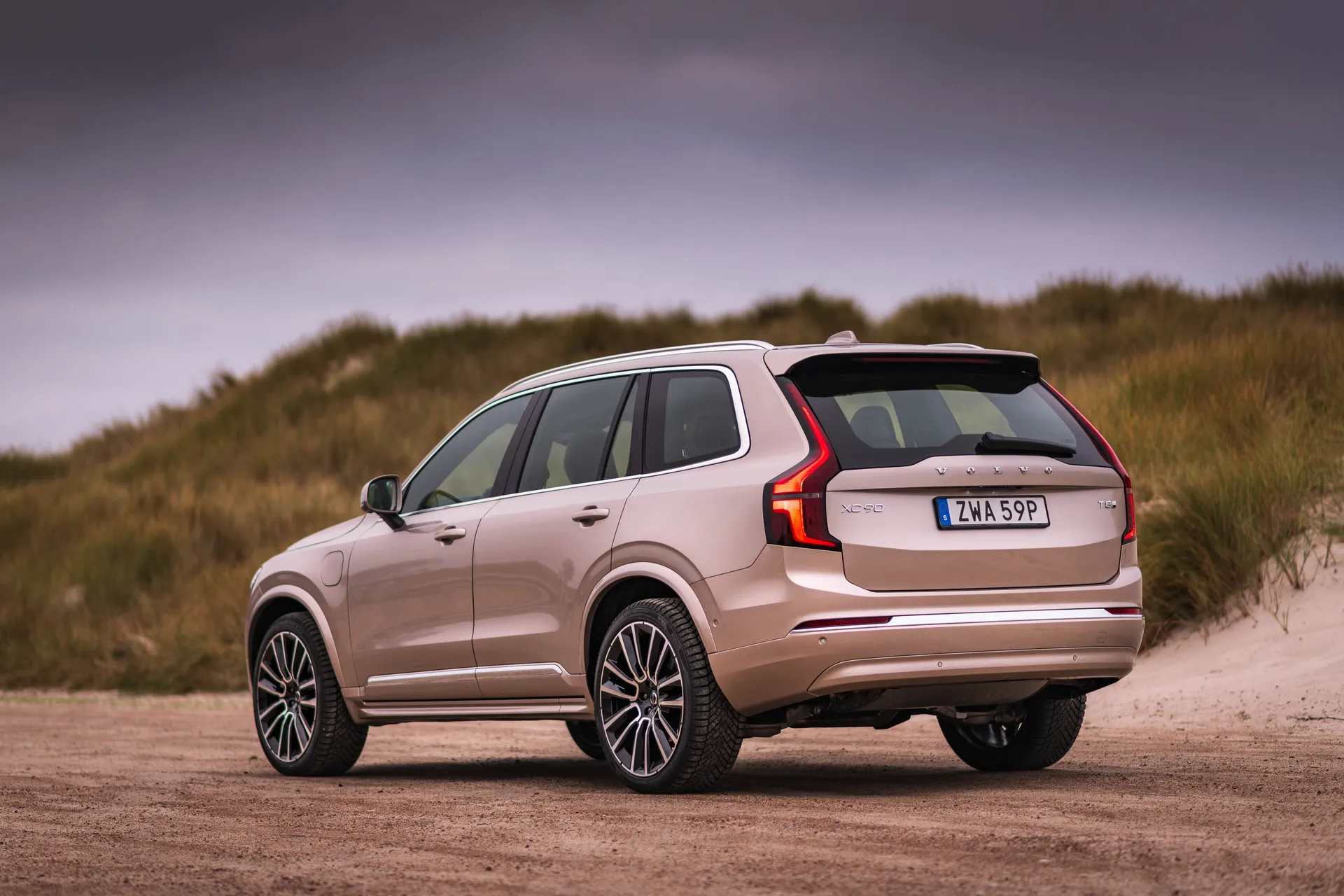
You’ll never see a figure like that in a month of Sundays in the real world, and what you do get will depend on a whole bunch of factors. For maximum efficiency, always make sure your battery is topped up with regular charges, and spend as much time driving on electric-only power as you can.
Choose a XC90 B5 with its mild hybrid assistance and it claims a combined economy of 32.8mpg, which is about what you'll see in normal driving.
Volvo XC90 reliability and warranty
Volvo puts in a fairly middle of the road performance in the annual HonestJohn.co.uk Satisfaction Index. We're not aware of too many issues with the XC90, aside from a few reports of electrical gremlins - particularly with PHEV models. It is quite a complex car, of course, but no more so than rivals.
The XC90 comes with a 3 year/60,000 mile warranty to cover any component failure that can be attributed to faulty materials or workmanship during manufacture.
Volvo XC90 insurance groups and costs
Insurance groups for this generation of XC90 range between 37 and 44, which means there won’t be a vast difference between the cheapest and most expensive premiums. True, such disparities could make a fairly big difference to young, newly qualified drivers, but let’s face it, most potential XC90 buyers will be of an age and income level where that shouldn’t be an issue. And for these folk, tiny fluctuations in insurance costs are unlikely to be deal-breaking in their choice of car.
VED car tax: What is the annual road tax on a Volvo XC90?
All cars with a list price of more than £40,000 - which includes all XC90s, unfortunately - get clobbered with an additional surcharge of £410 on top of whatever the car’s CO2 tax banding demands you pay. So, aside from the odd fluctuation of a tenner here and there, all XC90s will get stung for an annual VED bill of around £600 until they reach their sixth birthday when the surcharge is dropped.
Buy a car registered before April 2017, and what you’ll pay in road tax between each version will differ greatly. The good news for those after the PHEV is that you’ll pay nothing in VED thanks to its super-low CO2 emissions. Pretty tempting, that. Mind you, buy a D5 of the same vintage and you’ll pay £200, while T6 buyers pay £320.
Volvo XC90 price
"At the time of writing, prices for new XC90s kicked off at just less than £64,000 for the B5 in entry-level Core trim, while the T8 in full dress Ultra spec costs from £84,150."
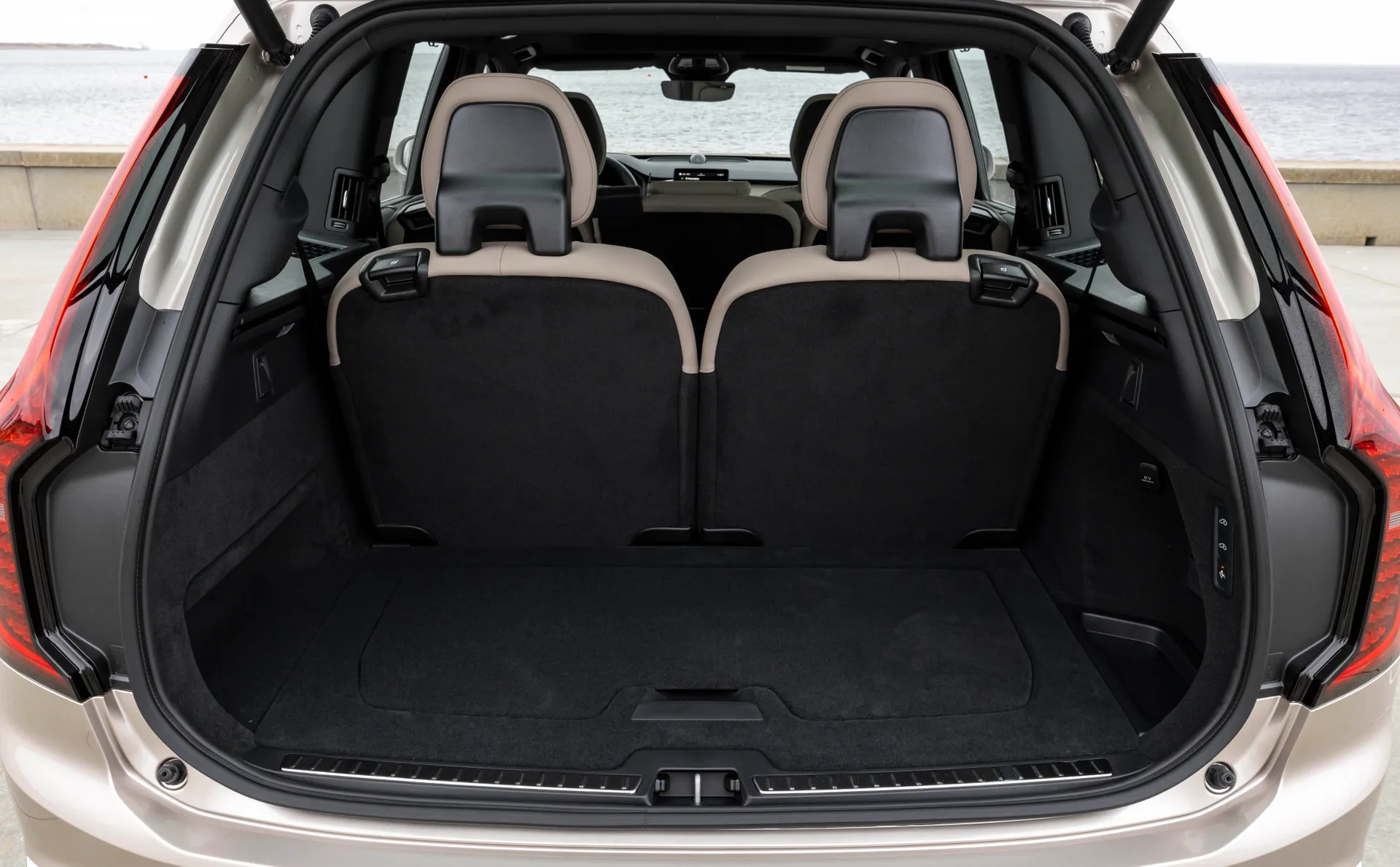
Compared with rivals like the Audi Q7 and BMW X5, the XC90’s pricing is pretty similar. A shade cheaper spec-for-spec, perhaps, but not by a massive amount. And, because the big Volvo’s resale values are also on a par with those of its German rivals (so pretty strong, then), you can expect prices to be pretty comparable on the used car market, too.
Obviously, buyers will pay a lot less for a used car than for a new one, but how much less will depend mostly on the age of the car you find. A nice pre-reg example will be like an entirely new car but for a very useful discount, while the cheapest versions we’ve seen check in from £16,000. That's for early high mileage cars, so expect a four-year old B5 Inscription model with 60,000 miles to cost around £29,000.
Trim levels and standard equipment
Both the B5 and T8 come in the choice of three trims - Core, Plus and Ultra. To be honest, spec an XC90 in Core spec and you still get a lot of kit. This includes that 11.2-inch touchscreen, 12-inch driver display, 20-inch alloy wheels, matrix-design LED headlights, four-zone climate control, heated windscreen, heated steering wheel, heated front and rear seats, rear camera, Pilot Assist adaptive cruise control and quilted Nordico upholstery.
Upgrading to Plus trim adds a panoramic roof and a Harman Kardon premium sound system, as well as active air suspension, a 360-degree camera and brown ash decor inside.
The top-spec XC90 Ultra model features an even more fancy Bowers & Wilkins sound system, ventilation and massage functions on the front seats (which are upholstered in Nappa leather), a head-up display and rides on 21-inch wheels (though can be upgraded to 22-inch alloys if you wish).
Looking at a used XC90 and you'll likely find Momentum, R-Design and Inscription trims, although exactly what you got with each one shifted around a wee bit, with more being added to the standard roster as time has went on.
To be honest, we can’t see much point in looking past the entry-level Volvo XC90 Momentum for used buyers because it’s really well equipped. Your standard roster includes automatic lights and wipers, keyless go, heated (in the front) leather seats, a hands-free powered tailgate and dual-zone climate control. That’s pretty good, right?
The Volvo XC90 R-Design models cost a lot more and add mostly sporty visual upgrades inside and out, although the climate control is enhanced to four-zone and you also get handy bits like heated washer nozzles and integrated sunblinds in the rear. The Volvo XC90 Inscription costs a bit more still and puts a focus on a luxury feel rather than a sporty one, and come with upgraded leather with seat ventilation, plus ambient lighting.
Ask the heycar experts: common questions
Is the Volvo XC90 a good car?
Is the Volvo XC90 a 7 seater?
What's the BMW equivalent of the XC90?
Get our latest advice, news and offers
Keep me updated by email with the latest advice, news and offers from heycar.
By submitting you agree to our privacy policy
